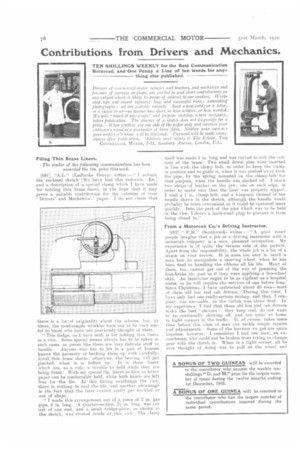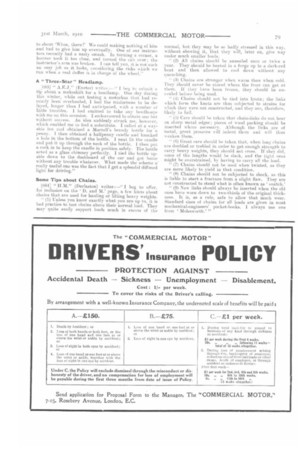Contributions from Drivers and Mechanics.
Page 16

Page 17

If you've noticed an error in this article please click here to report it so we can fix it.
Filing Thin Brass Liners.
The sender of the following communication has been awarded the 10s. prize this week.
[681] "AL" (Ladbroke Grove) writes:—" I submit the enclosed sketch [We have had this redrawn.—En.] and a description of a special clamp which I have made for holding thin brass liners, in the hope that it may prove a suitable contribution for the columns of your Drivers' and Mechanics" pages. 1 do not claim that there is a lot of originality about the scheme, but, at times, the most-simple wrinkles turn out to he very useful to those who have not previously thought of them.
" This dodge, as I have said, is for holding thin liners in a vice. Some special means always has to be taken in such cases, as pieces like these are very delicate stuff to handle. Anyone who has to let in a pair of brasses knows the necessity of backing them up with carefullyfitted thin brass sheets; otherwise, the bearing will get pinched, when it is bolted up. It is these liners which are, as a rule, a trouble to hold while they are being fitted. With my special rig, liners as thin as letter paper can be comfortably held, while both hands are left free for the file. As this fitting overhangs the vice, there is nothing to foul the file, and another advantage is the fact that the liner cannot easily get buckled or out of shape.
"I made this arrangement out of a piece of 2 in. gas pipe, 6 in. long. A quarter-section. D., in. long, was cut out of one end, and a small bridge-piece, as shown in the sketch, was riveted inside at this trol. The clamp itself was made 4 in. long and was curved to suit the contour of the brass. Two small dowel pins were inserted in line with the damp bolt, in order to keep the clamp in position and to guide it, when it was pushed away from the pipe, by the spring mounted on the clamp-bolt for that purpose, when the handle was slacked off. I stuck two strips of leather on the jaw, one on each edge. in order to make sine that the liner was properly nipped. I used a in. clamp-bolt, and a wing-nut instead of the handle shown in the sketch, although the handle would probably be more convenient as it could be operated more quickly. Into the part of the pipe which was to be held in the vice, I drove a hard-wood plug to prevent it from being closed in."
From a Motorcab Co.'s Driving Instructor.
L682] " F.M." (Southwark) writes :—" A good ninny people imagine that a job as a driving instructor with a motorcab company is a nice, pleasant occupation. My experience is of quite the reverse side of the picture. Apart from the responsibility, the whole job is a bit of a strain on your nerves. It is none too easy to teach a man how to manipulate a steering wheel, when he has been used to handling the ribbons all his life. Many of them, too, cannot get out of the way of jamming the foot-brake on, just as if they were applying a bus-wheel skid. An instructor ought to be as vigilant as a hospital nurse, or he will require the services of one before long. Since Christmas, I have instructed about 40 men—most of them old bus and cab drivers. During this time. I have only had one. really-serious mishap, and that. I consider, was excusable, as -the victim was stone deaf. In my experience, I find that these old bus and cab drivers make the best shovers ' ; they keep cool, do not want to be continually showing off, and are quite at home in tight corners in the traffic. It, of course, takes some time before this class of man can tackle simple repairs and adjustments. Some of the learners we get are quite hopeless, however. I remember I had one man, an excoachman, who could not be broken from trying to change gear with the clutch in. When in a tight corner, all he ever thought of doing was to pull at the wheel and to shout 'Whoa, there!' We could making nothing of him and had to give him up eventually. One of our instructors recently had a nasty smash. In turning a corner, a learner took it too close, and turned the cab over: the instructor's arm was broken. I can tell you, it is not 6 Itch an easy job as it looks, considering the risks nhich we run when a real duffer is in charge of the wheel."
A " Three.-Star " Headlamp.
A.E.J." (Exeter) writes I beg to submit a
tip about a makeshift for a headlamp. One day during this winter, while out testing a motorbus that Lad recently been overhauled, I had the misfortune to be delayed, longer than I had anticipated, ivith a number of little troubles. I had omitted to take any headlamps with me on this occasion. I endeavoured to obtain one but without success. An idea suddenly struck me, however, which enabled me to find a substitute. I called at a wayside Mu and obtained a Martell's brandy bottle for a penny. 1 then obtained a halfpenny candle and knocked a hole in the bottom of the bottle, I next lit the candle and put it up through the neck of the bottle. I then put a cork in to keep the candle in position safely. The bottle acted as a glass chimney perfectly. I tied the bottle upside down to the dashboard of the car and got home without any trouble whatever. What made the scheme a' really useful one was the fact that I got a splendid diffused light for driving."
Some Tips about Chains.
[684] " H.M." (Darlaston) writes :--" I beg to offer, for inclusion an the D. and M.' page, a few hints about chains that are used for hauling or lifting heavy weights.
" (1) Unless you know exactly what you are up to, it is bad practice to test chains above their normal load. They may quite easily support loads much in excess of the
normal, but they may be so badly stressed in this way, without showing it, that they will, later on, give way under much smaller loads.
" (2) All chains should be annealed once or twice a year. They should be heated in a forge up to a dark-red heat and then allowed to cool down without any quenching.
(3) Chains are stronger when warm than when cold. They should never be stored where the frost can get at them. If they have been frozen, they should be annealed before being used. " (4) Chains should not be tied into knots ; the links which form the knots are thus subjected to strains for which they were not constructed, and they are, therefore, likely to fail.
" (5) Care should be taken that chain-links do not bear on sharp metal edges; pieces of wood packing should be inserted where necessary. Although the links are of metal, great pressure will indent them and will thus weaken them.
" (6) Creat care should be taken that, when long rhains are doubled or trebled in order to get enough strength to carry heavy weights, they should not cross. If they did, some of the lengths would be slack, and the tight ones might be overstrained, by having to carry all the load. " (7) Chains should not be used when twisted, as they are more likely to yield in that condition.
" (8) Chains should not be subjected to shock, as this is liable to start a fracture from a slight flaw. They are not constructed to stand what is often known as snatch.'
" (9) New links should always be inserted when the old ones have worn down to two-thirds of the original thick
ness. It is, as a rule, safe to allow that much wear. Standard sizes of chains for all loads are given in most mechanical-engineers' pocket-books. 1 always use one from Molesworth.' "


















